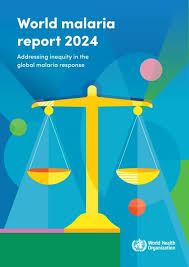World Malaria Report 2024

- 12 Dec 2024
In News:
The World Malaria Report 2024 released by the World Health Organization (WHO) highlights significant progress in malaria control, particularly in India, but underscores the continued burden of malaria in Southeast Asia, where India accounts for half of all malaria cases.
About Malaria:
- Cause: Malaria is caused by Plasmodium parasites, primarily P. falciparum and P. vivax, transmitted through bites from infected female Anopheles mosquitoes.
- Transmission: Non-contagious; transmitted via mosquito bites.
- Symptoms: Fever, chills, and headaches appear 10–15 days after the mosquito bite. In some individuals, the symptoms may be mild.
- Prevention: Includes vector control strategies like insecticide-treated bed nets and indoor spraying. Malaria is treatable with early diagnosis and prompt medication.
India’s Malaria Status:
- Progress:
- India has made significant strides in reducing malaria, with cases decreasing from 22.8 million in 2000 to 4 million in 2023, a reduction of 82.4%.
- Similarly, malaria-related deaths dropped by 82.9%, from 35,000 in 2000 to 6,000 in 2023.
- Exit from High-Burden-High-Impact (HBHI) Group:
- India exited this group in 2024, signaling its success in reducing malaria burden.
- Cases dropped by 69% (from 6.4 million in 2017 to 2 million in 2023), and deaths fell by 68% (from 11,100 to 3,500 in the same period).
Key Strategies Behind India's Success:
- Artemisinin-Based Combination Therapy (ACT): Used to treat malaria effectively.
- Long-Lasting Insecticidal Nets (LLIN): Widely deployed to control mosquito populations.
- Targeted Interventions: Focused on forested and tribal areas where malaria transmission is higher, particularly in states like Jharkhand, Odisha, and the North-East.
- Effective Monitoring: Ensures proper implementation of strategies and interventions.
WHO's Global Malaria Report 2024 Highlights:
- Global Burden: In 2023, there were 263 million malaria cases globally and 597,000 deaths. The African region remains the hardest hit, accounting for 95% of malaria deaths.
- Progress Since 2000: Malaria incidence and deaths have significantly decreased. The global number of malaria cases and deaths dropped substantially, with over 2.2 billion cases and 12.7 million deaths averted.
- Malaria-Free Countries: As of November 2024, 44 countries and one territory, including Egypt, have been certified malaria-free.
- Emerging Threats: Drug resistance (especially to Artemisinin) and insecticide resistance are growing concerns, affecting control efforts.
India and Southeast Asia:
- India contributes nearly half of the malaria cases in Southeast Asia, while Indonesia accounts for about one-third. Despite progress, India and Indonesia together accounted for 88% of malaria deaths in the region.
- South-East Asia Progress: The region reduced malaria cases by 82.4% from 22.8 million in 2000 to 4 million in 2023. Timor-Leste and Bhutan reported zero indigenous malaria cases in 2023.
Global Recommendations:
- WHO stresses the need for continued investment, innovative strategies, and targeted actions, especially in high-burden areas like Africa, to sustain progress and tackle remaining challenges, such as drug resistance, insecticide resistance, and new vector species like Anopheles stephensi, which thrives in urban areas.
